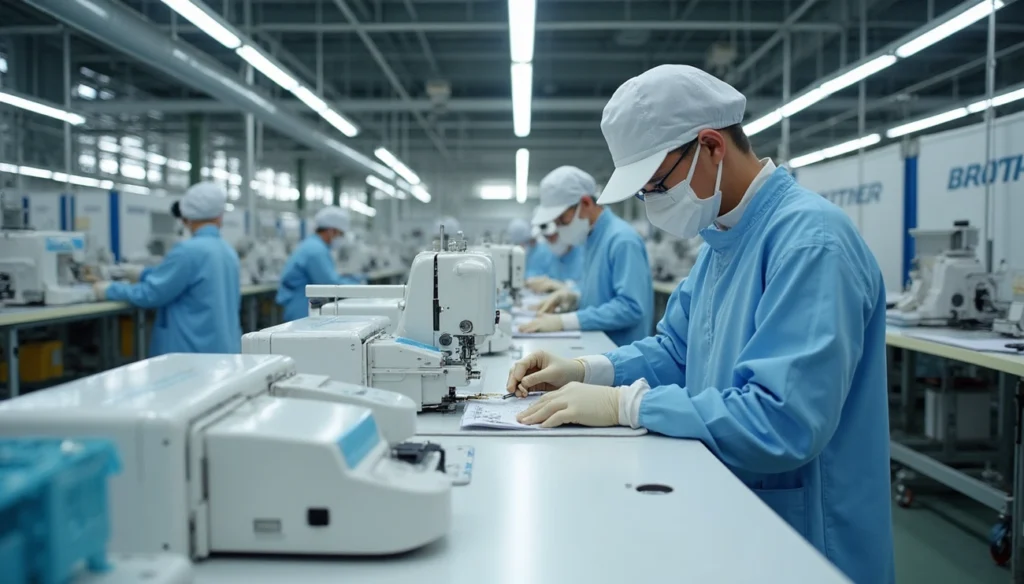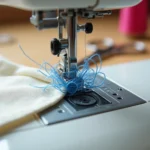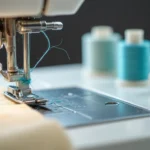Brother sewing machines are made in countries including Japan, Taiwan, China, and Vietnam. The company’s main production hub is in Dong Nai, Vietnam, which handles a large portion of global output. Some higher-end models are still manufactured in Japan to maintain premium quality standards.
Where Are Brother Sewing Machines Made?
Brother’s global manufacturing strategy spans multiple continents with specialized production facilities strategically positioned to serve worldwide markets. Each location plays a distinct role in their manufacturing ecosystem, contributing to the company’s remarkable output of 70 million machines by 2022.
Japan: The original manufacturing base
The story of Brother’s manufacturing begins in Nagoya, Japan, where the company still maintains its global headquarters. Production in Japan started in 1932 at the Tenman-Cho Factory with the “Type 15 Model 70”. Today, Brother operates multiple factories across different wards of Nagoya. These Japanese facilities primarily focus on high-precision components and specialized industrial machines while serving as the nerve center for global operations.
After the late 1990s, Brother actively shifted much of its production to other Asian countries while maintaining critical operations in Japan. Nevertheless, the Japanese facilities remain essential for research, development, and specialized manufacturing, upholding the tradition of Japanese craftsmanship that has defined the brand for decades.
China: Mechanical sewing machine production
In China, Brother produces most of its mechanical and entry-level sewing machines at facilities in Zhuhai. This manufacturing hub was strategically chosen for its renowned manufacturing expertise and ability to handle large-scale production efficiently. The Zhuhai facilities specialize in creating reliable, cost-effective models for global markets.
Furthermore, Brother established BROTHER MACHINERY XIAN CO., LTD. in China in 2001, expanding its industrial sewing machine manufacturing capabilities. This move allowed Brother to optimize production costs while maintaining the quality standards expected from the brand.
Taiwan: Computerized and embroidery machines
Taiwan plays a crucial role in Brother’s manufacturing network, producing the company’s computerized sewing and embroidery machines. The Taiwan facilities were selected particularly for the country’s advanced technology and precision engineering capabilities. This strategic choice balances cutting-edge technology with efficient manufacturing processes.
In 2003, Brother began manufacturing commercial/multi-needle embroidery machines in Taiwan. All Brother PR series embroidery machines are produced at Taiwan Brother Industries AG in Kaohsiung City. The facility leverages Taiwan’s technological expertise for these sophisticated machines that require advanced electronics and precision components.
Vietnam: World’s largest single-brand sewing machine factory
Perhaps most impressive is Brother’s facility in Đồng Nai Province, Vietnam, opened in 2012. This state-of-the-art factory holds the distinction of being the largest single-brand sewing machine factory in the world. The facility supports both home and industrial machine production, representing a significant investment in Brother’s manufacturing future.
In addition to the Đồng Nai facility, Brother Vietnam Co. Ltd opened a new $30 million factory in Phuc Dien Industrial Park, Hai Duong province in January 2018. This factory—Brother Vietnam’s fourth in the country—was expected to create jobs for 2,000 local workers. While primarily focused on printers and fax machines, it demonstrates Brother’s expanding manufacturing presence in Vietnam.
Through this diverse global manufacturing network spanning Japan, China, Taiwan, and Vietnam, Brother effectively balances tradition with innovation while meeting worldwide demand. Each location contributes unique strengths to the company’s production capabilities, allowing Brother to maintain its reputation for excellence across diverse price points and machine categories.
Inside Brother’s Global Manufacturing Network
Beyond the major manufacturing hubs detailed earlier, Brother Industries operates an expansive global network of facilities that work in harmony to produce their diverse product line. This interconnected system represents one of the most sophisticated manufacturing operations in the consumer electronics industry.
Overview of Brother’s international factories
Brother’s manufacturing footprint spans 17 production facilities across eight countries globally. This expansive network employs more than 42,801 people worldwide and generates annual revenues exceeding ¥876.56 billion. First and foremost, these facilities operate under Brother’s unique “BROTHER VALUE CHAIN MANAGEMENT” (BVCM) system—a comprehensive approach that integrates development, manufacturing, and sales operations.
The company’s production strategy divides facilities by specialty rather than simply geography. Consequently, each factory develops expertise in specific product lines or manufacturing processes. The Brother Group manufacturing network consists of:
- Sewing machine specialists: Factories in China, Taiwan, Vietnam, and Japan
- Printing equipment centers: Facilities in Vietnam, Malaysia, Philippines, and the US
- Industrial equipment producers: Specialized operations in Japan and China
- Document scanning hubs: UK and Slovakia facilities
In essence, this specialized approach allows Brother to maintain consistent quality while optimizing production efficiency across varied economic environments.
Factory locations in the US, UK, Malaysia, and more
Apart from the major sewing machine factories covered previously, Brother operates several other significant manufacturing facilities:
In the United States, Brother operates Brother Industries (U.S.A) in Bartlett, Tennessee, established in 1987. This facility focuses primarily on high-speed industrial printers and recycled toner cartridges, serving North American markets directly.
The United Kingdom hosts Brother Industries (U.K.) Ltd. in Wrexham, Wales. Founded in 1985, this facility specializes in manufacturing recycled toner cartridges through advanced manufacturing processes.
Malaysia became home to Brother Industries Technology (Malaysia) Sdn. Bhd. in 2003, which produces printing and communications equipment. The facility in Kedah has developed specialized expertise in label printers and portable printing solutions.
Additionally, the Philippines houses Brother Industries (Philippines), Inc., established in 2012 in Batangas. This factory primarily manufactures printers, all-in-ones, and electronic stationery products.
Brother Industries Slovakia s.r.o., founded in 2006, produces essential components and assemblies for document scanners, further expanding the company’s European manufacturing presence.
How Brother ensures quality across regions
Maintaining consistent quality across diverse manufacturing locations presents significant challenges. Nonetheless, Brother implements several strategies to ensure uniformity regardless of where products are made.
The cornerstone of Brother’s quality approach is their globally standardized “Brother Group Global Charter.” This document codifies manufacturing practices, environmental standards, and quality requirements for all facilities worldwide.
Moreover, Brother maintains a centralized product development system based in Japan, where all designs originate before being distributed to manufacturing facilities. This ensures consistency in specifications and performance standards regardless of production location.
Every manufacturing facility undergoes regular certification processes, including ISO 9001 for quality management and ISO 14001 for environmental standards. Notably, Brother uses identical testing equipment and procedures at each location, effectively standardizing quality control globally.
Brother also employs a unique “mother factory” system where expertise developed at the original Japanese facilities is systematically transferred to newer factories. Technical specialists from Japan regularly visit international sites to provide training and quality oversight.
Through these comprehensive approaches, Brother maintains the quality standards that have defined the brand for over a century—regardless of where in the world their products are manufactured.
How Brother Maintains Quality and Innovation
Quality forms the cornerstone of Brother’s manufacturing philosophy across all organizational levels. As a global leader in sewing technology, Brother has developed sophisticated systems to maintain exceptional standards regardless of where their machines are produced.
Use of advanced technology in production
At the heart of Brother’s quality control system is their unique approach to manufacturing—products are developed, designed, and manufactured by Brother employees in Brother-owned facilities. This vertically integrated approach ensures complete control over the production process. In fact, each home sewing machine is built by hand, allowing Brother to maintain their high standards of quality and reliability.
Brother’s production facilities feature advanced automation systems that deliver high precision while remaining energy-efficient. Their industrial equipment evolved directly from manufacturing machine tools needed for sewing machine parts. These compact machines offer both high productivity and energy-saving performance, making them valuable for various industries.
Integration of IoT in industrial machines
Perhaps the most significant technological breakthrough in Brother’s recent manufacturing history is the development of their NEXIO system—the world’s first IoT-applicable industrial sewing machines. This innovation enables unprecedented connectivity between machines and management systems.
The NEXIO platform delivers real-time data analytics accessible through multiple devices including mobile phones, tablets, and computers. Unlike traditional production management systems that only track final output, NEXIO analyzes and evaluates processes themselves. This capability has yielded impressive results, with implementation in a Vietnamese garment factory achieving a 5% productivity gain through real-time defect tracking.
Brother’s IoT technology facilitates transparent and streamlined processes that ultimately reduce production costs. The system is secured through AWS cloud servers, HTTPS data encryption, and independent data structures.
Design and R&D centers in Japan
Behind Brother’s technological innovations stands a robust research and development infrastructure centered in Japan. The Technology Development Center in Nagoya’s Mizuho Ward serves as the primary hub for creating next-generation sewing technologies.
Brother employs a three-tier R&D system comprising a centralized institute at headquarters, dedicated centers within business divisions, and technological hubs integrated with production bases. This structure ensures innovation is woven into every aspect of product development.
Through their commitment to advanced technology and continuous innovation, Brother maintains the exceptional quality that has defined their brand for over a century.
Beyond Sewing: Brother’s Global Product Line and Impact
Although widely recognized for sewing machines, Brother Industries has expanded far beyond its original focus to become a diversified technology company with a truly global footprint. This expansion demonstrates how Brother has applied expertise from sewing machine production to various other industries.
Printers, label makers, and more
Brother’s product portfolio now encompasses:
- Printers and multifunction devices
- Label makers and mobile solutions
- Scanners and fax machines
- Typewriters and word processors
- Industrial equipment and machine tools
- Garment printers and direct-to-garment technology
Despite this diversification, Brother maintains manufacturing consistency across product lines. The same facilities that produce sewing machines often manufacture components for these other products, especially in their Vietnam operations. This strategic approach allows Brother to leverage specialized manufacturing expertise across multiple product categories.
Brother’s OEM partnerships
Throughout its expansion, Brother has formed original equipment manufacturer (OEM) partnerships with other major brands. These collaborations allow Brother to manufacture components or complete products sold under different brand names, effectively expanding their market reach without diluting their core identity.
The company’s OEM relationships extend beyond consumer products into industrial applications. Brother’s expertise in precision mechanics makes them valuable partners for companies requiring high-quality components. These partnerships benefit from the same manufacturing excellence that characterizes their sewing machine production.
Philanthropy and social responsibility
Above all, Brother Industries prioritizes social responsibility alongside business growth. The company implements comprehensive sustainability programs across all manufacturing locations, including those producing sewing machines. Their environmental initiatives focus on reducing carbon emissions, minimizing waste, and developing eco-friendly products.
The Brother Group actively contributes to communities where they operate through education support programs and disaster relief efforts. These philanthropic activities reflect the same family values that inspired the “Brother” name itself—cooperation, support, and mutual respect. From their origins as a small Japanese sewing machine repair shop to today’s global corporation, these principles have remained constant through more than a century of business evolution.
Conclusion
From a humble repair shop in Nagoya to the world’s largest single-brand sewing machine factory in Vietnam, Brother’s journey spans over a century of innovation and growth. Undoubtedly, the strategic distribution of manufacturing across Japan, China, Taiwan, and Vietnam has allowed Brother to balance tradition with cutting-edge technology while serving global markets efficiently.
Though Brother began with sewing machines, the company has successfully applied its manufacturing expertise to expand into printers, label makers, industrial equipment, and more. Still, regardless of where a Brother machine is made, the company maintains exceptional quality through standardized practices, centralized product development, and their unique “mother factory” system.
What stands out most about Brother is how they’ve grown from Yasui Sewing Machine Co. to a multinational corporation with over 42,800 employees while preserving their founding values. The very name “Brother” reflects the family cooperation that built this brand—a spirit that continues in their business practices and community involvement today.


